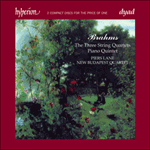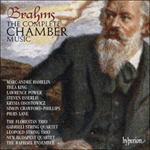
Welcome to Hyperion Records, a British classical label devoted to presenting high-quality recordings of music of all styles and from all periods from the twelfth century to the twenty-first.
Hyperion offers both CDs, and downloads in a number of formats. The site is also available in several languages.
Please use the dropdown buttons to set your preferred options, or use the checkbox to accept the defaults.

| New Budapest Quartet» More |
For all their musical richness, it is possible to feel that the orchestrally inclined outer movements are less successful in terms of quartet writing than the two middle movements, both of which are perfect and intimate miniatures. From a harmonic point of view, however, the first movement shows Brahms’s style at its boldest. The tense opening theme, with its pulsating accompaniment on viola and cello, is followed immediately by a more lyrical idea that modulates remarkably widely for so early in the piece. (This was a passage much admired by Schoenberg, who cited it in an essay entitled ‘Brahms the Progressive’.) No less striking is the manner in which Brahms treats the start of the recapitulation, much later in the movement, allowing the main theme to enter before the home key has been re-established. The seamless join is one that effectively prolongs the tension of the preceding development section.
The horn-call that inaugurates the slow movement is woven into the accompaniment of the warmly expressive main theme itself. The theme is handed over from violin to cello for a counterstatement, as though it were to form the basis of a set of variations; but there is no such quasi-repeat for the melody’s second half, which instead gives way to the halting phrases of a more pleading middle section. When the original melody returns it does so in an elaborately ornamented form, as if to confirm the variation background of the movement’s beginning.
If the ‘panting’ phrases that set the F minor third movement in motion offer a distant memory of the finale from Beethoven’s quartet in the same key Op 95, its second theme—a mellifluous, ‘swaying’ duet for viola and first violin—is as thoroughly Brahmsian as could be imagined. The trio section in the major has its theme accompanied by a curious ‘croaking’ sound from the second violin. The effect is produced by rapidly alternating the same pitch between adjacent ‘open’ and ‘stopped’ strings—an idea Brahms will have learned not from Beethoven, but from Haydn, whose quartets he deeply admired. Haydn’s most famous example of this bariolage technique, as it is called, occurs in the finale of his D major Quartet Op 50 No 6, where its use has lent the work as a whole the nickname of the ‘Frog’.
from notes by Misha Donat © 2008
Malgré leur richesse musicale, on peut sentir que les mouvements extrêmes, de tendance orchestrale, sont moins réussis, sur le plan de l’écriture de quatuor, que les deux mouvements centraux, qui sont de parfaits et profondes miniatures. D’un point de vue harmonique, cependant, le premier mouvement montre le style brahmsien dans ce qu’il a de plus audacieux. Le thème initial tendu, avec son lancinant accompagnement à l’alto et au violoncelle, est immédiatement suivi d’une idée plus lyrique qui module bien largement, étant donné que nous sommes ici dans la toute première phase du morceaux. (Ce passage fut très admiré par Schoenberg, qui le cita dans un essai intitulé «Brahms le progressiste».) Tout aussi saisissante est la manière dont Brahms traite le début de la réexposition, beaucoup plus tard dans le mouvement, laissant le thème principal entrer avant le rétablissement de la tonalité-mère. La jonction sans heurt prolonge efficacement la tension du développement précédent.
L’appel de cor qui inaugure le mouvement lent est inséré dans l’accompagnement du thème principal même, chaleureusement expressif. Ce thème passe du violon au violoncelle pour une contre-exposition, comme pour servir de socle à une série de variations; mais ce genre de quasi-reprise n’existe pas pour la seconde moitié de la mélodie, qui cède la place aux phrases heurtées d’une section centrale plus instante. Lorsque la mélodie originale revient, c’est sous une forme à l’ornementation complexe, comme pour confirmer le fond de variations du début.
Si les phrases «haletantes» qui mettent en branle le troisième mouvement en fa mineur rappellent vaguement le finale du Quatuor en fa mineur op. 95 de Beethoven, le deuxième thème—un mélodieux duo «chaloupé» pour l’alto et le premier violon—est brahmsien à souhait. La section en trio, en majeur, voit son thème accompagné par un curieux «coassement» au second violon. Cet effet, obtenu en faisant alterner rapidement la même hauteur de son entre des cordes voisines «à vide» et «touchée», Brahms l’aura appris non de Beethoven mais de Haydn, dont il admirait profondément les quatuors. Le plus célèbre exemple haydnien de cette technique dite de bariolage survient dans le finale du Quatuor en ré majeur, op. 50 no 6—d’où le surnom de «Grenouille» donné à cette œuvre.
extrait des notes rédigées par Misha Donat © 2008
Français: Hypérion
Trotz des musikalischen Reichtums der Außensätze mag man den Eindruck bekommen, als würden diese sich einem Orchesterklang nähernden Sätze als Quartettschöpfungen weniger überzeugen als die zwei mittleren Sätze, die beide perfekte und persönliche Miniaturen darstellen. Von einem harmonischen Standpunkt aus gesehen wagt sich Brahms’ Stil allerdings am meisten im ersten Satz vor. Das gespannte erste Thema mit seiner pulsierenden Begleitung aus Bratsche und Violoncello wird sofort von einem lyrischeren musikalischen Gedanken gefolgt, der erstaunlich umfangreich moduliert, wenn man bedenkt, wie früh im Stück man sich hier befindet. (Schönberg bewunderte gerade diese Passage sehr und zitierte sie in seinem Aufsatz „Brahms, der Fortschrittliche“.) Nicht weniger auffällig ist die Art, mit der Brahms viel später im Satz den Anfang der Reprise gestaltet, wo er das Hauptthema schon einsetzen lässt, noch bevor die Grundtonart erneut befestigt wurde. Der nahtlose Übergang hält so die Spannung des vorangegangenen Durchführungsabschnittes wirksam bei.
Der den langsamen Satz einleitende „Hornruf“ fließt in die Begleitung des gefühlvoll ausdrucksstarken Hauptthemas ein. Das Thema wird von der Violine für ein Gegenthema zum Violoncello weitergereicht, als solle es die Grundlage für eine Variationsreihe bilden. Die zweite Melodiehälfte findet für diese Vorspieglung allerdings keine Wiederholung, sondern fällt zugunsten der zögernden Gesten eines flehenderen Abschnitts weg. Wenn die ursprüngliche Melodie dann erneut erklingt, geschieht das in einer umfangreich verzierten Art und Weise, als sollte die zu Beginn des Satzes geschaffene Illusion einer Variationsreihe bestätigt werden.
Die „keuchenden“ Phrasen, die den dritten Satz, in f-Moll, in Bewegung setzen, mögen einen fernen Anklang an den Schlusssatz aus Beethovens Quartett op. 95 in der gleichen Tonart enthalten, doch könnte das zweite Thema—ein süßes, „schunkelndes“ Duett für Viola und erste Violine—nicht typischer für Brahms sein. Der in Dur gehaltene Trioabschnitt hat ein Thema, das von einem merkwürdig „quakenden“ Klang der zweiten Violine begleitet wird. Die Wirkung entsteht durch den sehr schnellen Wechsel zwischen einem Ton, der auf einer „leeren“ Saite gespielt wird, und dem gleichen Ton auf einer „abgegriffenen“ Saite—ein Einfall, den Brahms wohl nicht von Beethoven, sondern von Haydn gelernt haben mag, dessen Quartette er zutiefst bewunderte. Haydns berühmtes Beispiel dieser Bariolage-Technik, wie man sie nennt, geschieht im Schlusssatz seines Quartetts op. 50 Nr. 6 in D-Dur, wo ihr Einsatz zur Namensgebung des gesamten Quartetts als „Froschquartett“ führte.
aus dem Begleittext von Misha Donat © 2008
Deutsch: Viola Scheffel
 Brahms: String Quartets & Piano Quintet Brahms: String Quartets & Piano Quintet‘Highly recommendable … Brahms is fortunate here’ (Gramophone) ‘The New Budapest are outstanding for the mellow warmth and refinement of their corporate sound. Hyperion's distinguished new issue was needed … ...» More |
 Brahms: The Complete Chamber Music Brahms: The Complete Chamber Music‘The pick of this crop has to be Brahms's Complete Chamber Music from Hyperion. Spanning more than two decades, this box contains the finest, mainly B ... ‘Immerse yourself in this set of 12 CDs of Brahms's chamber music … in the last 25 years, Hyperion has managed to persuade some of the finest of ...» More |

